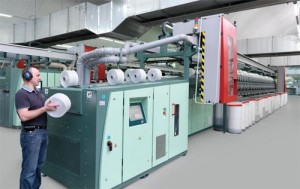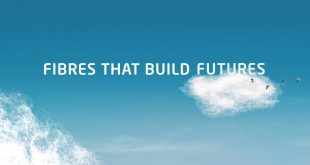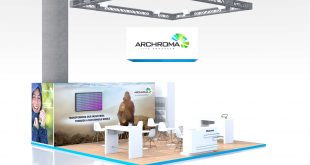 The J 20 is a production miracle with smallest space requirements. With its high operating speed of up to 450 m/min and 120 spinning units, the J 20 air-spinning machine heads the productivity scale. Thanks to the newly developed duo-spinning unit, the J 20 offers maximum yarn quality, productivity and flexibility.
The J 20 is a production miracle with smallest space requirements. With its high operating speed of up to 450 m/min and 120 spinning units, the J 20 air-spinning machine heads the productivity scale. Thanks to the newly developed duo-spinning unit, the J 20 offers maximum yarn quality, productivity and flexibility.
Why a new spinning technology? High productivity, low manufacturing costs per kilogram of yarn and innovative yarn properties – the development team keeps all these targets constantly in sight with the development of the air-spinning process. Achieving these by the step-by-step evolution of existing technologies is not possible. The development of the J 10 air- spinning machine began in 2003. The market launch of the air-jet spinning technology has been carried out progressively since June 2008. The practical experience gained with the J 10 air-spinning machine has been integrated into the J 20 air-jet spinning machine . The J 20 is the 2nd generation of air-jet spinning machines produced by Rieter and since the ITMA 2011 is now being marketed worldwide.
The mechanical engineering concept of the air-spinning machine
The main development requirements were: •High productivity.•Market-conform yarn and bobbin quality. •Flexible, simple machine settings. •Easy to operate. •Low downtimes for maintenance and lot changes. •Innovative yarn properties that open new markets for spinning plants. •Adjustable yarn properties. •Low production costs per kilogram of yarn. •Space-saving installation/assembly, easy to integrate in existing spinning plants These requirements have determined the machine concept, the individual components, the automation as well as the operating philosophy.
The high-performance concept of the J 20
In order to achieve delivery speeds of 450 m/min, numerous innovations have been incorporated in the J 20 air-jet spinning machine. In comparison: usual delivery speeds are 15-27 m/min with ring spinning and 130-250 m/min with rotor spinning. The construction of the Rieter air-jet spinning machine is similar to that of a rotor spinning machine. Between the drive frame and the end frame are 6 sections each with 20 spinning positions. 4 robots – 2 on each side – are in operation for the formation of yarn piecings, bobbin change and cleaning (Fig. 1). Construction of sections and the machine height are selected to allow 500 mm (20”) round cans with 1 070 or 1 200 mm can height to be placed in 2 rows under the machine. The large can size permits a long lifecycle and thereby reduces the number of can changes. As with the rotor spinning machine, the sliver to be spun is fed from the can bottom. This short, direct route from the can to the drafting arrangement practically eliminates the risk of faulty drafts. An enormously important aspect, as with Rieter air-jet spinning, fine sliver is used to ensure optimal drafts at high speeds. To keep the operator requirements and the costs as low as possible, an empty tube feeder is utilized in which 350 bobbins can be creeled. The empty tubes are automatically fed to the robot – just in time – as soon as a bobbin change takes place. The bobbin diameter can be up to 300 mm.
The tube feeder has 2 separate bobbin chains and can therefore supply tubes of different colors for the left and right machine sides. This eliminates the risk of tubes being mixed up when 2 yarn qualities are being simultaneously produced. The J 20 air-jet spinning machine uses a winding system whereby 2 contra-rotating wings precisely guide the yarn. With this winding system, ribbon windings definitely belong to the past. The cross-angle can be freely set between 15° and 46°. It is possible to use standard bobbins or colored bobbins on the J 20. The winding system with continuously rotating wings offers the potential for future increases in production rates. Due to the increased spinning stability with the new duo drafting arrangement, the J 20 air-jet spinning machine can – in comparison with the J 10 – be extended by one section. With 120 spinning positions, the J 20 is therefore the longest air-jet spinning machine in the world.
Machine construction for optimized production process
Construction of the J 20 – as compared to the J 10 – has been further optimized. The centrally- driven ventilators, the entire electrics and electronics as well as the supply and disposal connections are integrated in the drive frame. The filter chambers for the waste from the spinning positions and from the robots are separated from each other and are also separate for the left and the right machine sides. The waste can therefore be individually sorted which guarantees purity of material type for further use. The bobbin delivery on the drive frame is set at an ergonomic height of 1.45 meters. This enables the operator to optimally control the bobbin conveyor belt and the bobbins can be conveniently removed and placed on pallets (Fig. 2). At the other end of the J 20 – between the last section and the tube loader – there is a free space as the service area for the robot at the rear.
Market-conform yarn and bobbin quality
With the J 20, the bobbin tension can be set over the whole bobbin. This, together with the image interference device, guarantees a perfect bobbin building process. The J 20 machines are equipped with the latest yarn clearer USTER Quantum Clearer 2; in line with the customer’s requirements – with capacitive or optical sensor – with or without foreign fiber detection. All yarn clearer settings are entered on the J 20 touch screen. All disturbing yarn faults, neps, thick or thin places and optionally also foreign fibers, are detected and cleared – an essential prerequisite for the downtime-free further processing of the yarn in weaving or knitting plants and a high-quality and even fabric appearance.
New duo-spinning unit
The new spinning unit of the J 20 achieves a high yarn strength and low number of imperfections. The drafting arrangement of the duo-spinning unit can be precisely and reproducibly set. Controlled fiber guiding leads to good yarn quality as well as to a low number of quality cuts and natural thread breakages. The operator involvement is significantly reduced. With the J 20 duo drafting arrangement the productivity – compared with that of the J 10 – can be increased by 5% and this with equal or improved yarn quality. With the duo-spinning unit, the field of application for the air-jet spinning machine has been successfully extended. The J 20 can process viscose, Modal and blends with cotton.
Deposits of fiber-fly and dirt are prevented by an optimized suction on the duo-spinning unit. There are practically no fiber deposits due to the open duo-drafting arrangement (Fig. 3). Any fiber-fly is removed by the robot in passing. The findings of the technological development and practical experience with the J 10 have been incorporated into the development of the J 20. The duo-spinning unit has numerous exchangeable technology elements with which it is possible to process different fiber materials and fiber counts or to achieve different yarn properties.
Automation with 4 robots
A J 20 air-spinning machine with 120 spinning positions is equipped with 4 robots, 2 on each side of the machine. The robot has various tasks: It cleans the spinning position and automatically pieces the yarn after a thread break or a clearer cut. It changes full bobbins and threads up the empty tubes – so-called doffing. A fan on the robot cleans the spinning positions from fiber-fly in passing. The robot of the J 20 is based on the automation technology of the rotor spinning machine. The well-proven Rieter piecing technology with almost yarn-like piecings leads to a high yarn quality.
The entire J 20 piecing process is electronically controlled, assisted by the yarn clearer, and settings can be made on the machine display panel. The step-by-step introduction of new fibers gives the piecing a yarn-like appearance. The spinning technology guarantees that all fibers of the yarn end are perfectly bound in the piecing process – contrary to conventional splicers (Fig. 5). The piecers thereby formed fulfill all requirements in downstream processing. The robot works with a high degree of dependability. If problems occur, a trouble shooting program is shown on the robot display so that faults can be remedied without an instruction manual. When one of the two robots is in the separate maintenance and service station, the other robot automatically operates over the entire machine side.
Flexible, simple machine settings
High production speeds mean that the lots to be spun are finished increasingly quickly. The faster a machine spins, the quicker it should be able to be set for new orders. The machine concept of the J 20 is therefore arranged so that both machine sides are optionally entirely independent of each other. This makes possible the production of 2 different articles, i.e. yarns at the same time and increases the production flexibility of the spinning plants. 2 bobbin transport belts and the separate conveyance of empty tubes with different colors (Fig. 4) prevent mix-ups when 2 articles are being produced simultaneously on the machine.
Individual drive of the spinning units
The heart of the J 20 air-jet spinning machine is the spinning unit that is driven by single motors, without central gears and without driving shaft, across the entire machine length. After an ends-down or a quality cut, the individual motors automatically stop the spinning position. The spinning unit no longer uses energy and compressed air. This also applies when the maintenance personnel carry out maintenance work. Only individual spinning positions are switched off and the rest of the machine continues production. The settings of the spinning units – such as drafts, bobbin speed, winding tension, cross-angle, spinning pressure – are carried out centrally via the machine operator panel. This enables rapid article change and increases the flexibility of the spinning plant. In addition, the machine carries out an automatic bobbin change and thereby prepares the change of article. Also with the evaluation of the machine data, top priority is given to flexibility. It goes without saying, that for each article, separate production and shift reports are available.
Lifecycle of technological parts
A great challenge with the high production speeds of the J 20 is to keep the maintenance costs as low as possible. With such high production speeds, high stress loads and abrasion levels occur. Rieter places great value on the application of new types of materials and solutions to gain long lifecycles of the relevant components. With the development of components, the physicists and chemists of Rieter’s material department always provide advice and support. For the J 20, ceramic spinning peaks were developed. These show distinctly higher lifecycles than spinning peaks made of steel. The ceramic spinning peaks are used in the production of viscose, Modal and cotton.
Leading drafting arrangement technology
Rieter’s cutting-edge drafting arrangement technology was adopted for the air-jet spinning machine and adapted to the high speeds. In order to achieve the enormously high drafts, the 3-over-3 drafting arrangement was further developed to a 4-over-4 drafting arrangement. This allows a gentle fiber drafting in 3 stages (pre-, middle and main draft). The robust J 20 drafting arrangement is equipped with a unique, patented traversing system. The feed sliver – and consequently the produced yarn – is laterally traversed. This lengthens the lifecycle of the top rollers cots and aprons on the J 20 three-fold. Accordingly the top rollers rarely need to be replaced. In the long term, this reduces the maintenance and spare parts costs enormously and ensures constant yarn quality over a long period of time. During the development process, care was taken that as many fiber materials as possible could be processed with the same top roller cots. The previous status of research and development with the aprons is that for viscose, Modal, cotton and blends, the same apron can be used. As top and bottom aprons in the drafting arrangement are identical, fewer aprons must be kept in stock as spares.
Low production costs per kilogram of yarn
For the majority of applications, the air-jet spinning technology has a lower energy consumption per kilogram of produced yarn than other spinning processes. Rieter’s calculations take the energy requirement for the compressed air preparation into account. The intelligent shutdown of the individual spinning units thereby pays off. The development process also paid attention to the dimensions of the J 20, to ensure that an installation in existing spinning rooms is possible. A spinning plant with J 20 needs a 25% smaller building area than a ring spinning plant for the same production capacity. This reduces the cost for buildings. A key for a perfect running behavior of the end spinning machines is a stable climate. Here the 25% lower space requirement of a J 20 compared to that of a ring spinning machine is of financial benefit. The smaller area that has to be air-conditioned results in substantial savings. Practical experience has clearly shown that the air-conditioning in the spinning plant has a great influence on the spinning quality and the production stability with air-jet spinning. Under difficult conditions, air-conditioning can be installed directly under the spinning machine. It directs conditioned air from below to the cans, i.e. to the sliver – exactly where it is needed. Compared with the climatic conditioning of a hall, such a system can save additional energy.
ComforJet® yarn – noticeably different
A new yarn with new yarn characteristics, that opens new market opportunities for spinning plants, was the focus of development of the new spinning technology. The development team has succeeded in meeting this challenge. The type of yarn formation – turbulence with an airflow in a spinning nozzle – leads to a novel, noticeably different yarn structure. This yarn from the J 20 machine is marketed under the trade name ComforJet ®. Air is a significant factor in the formation of the ComforJet® yarn and influences the yarn structure. For this reason, the ComforJet® yarns differ from ring and rotor yarns (Fig. 6) and have unique properties which show their advantages not only in the processing but also in the end article and end use.
ComforJet® yarn with defined hairiness
With the J 20 air-jet spinning machine, the hairiness and the yarn volume can be changed and reproduced via the machine setting. This flexibility is not found with any other spinning system to this extent. With the ComforJet® spinning process the drafted fibers run into a spinning nozzle. The front part of the fibers form the yarn core. The loose fiber ends are wound around the parallel yarn core by the air stream – it can be imagined as the fiber sun – in the spinning nozzle (Fig. 7/Fig. 8). The yarn surface is very smooth. The fibers that form the hairiness are very short or form small loops. This produces the typical properties of the ComforJet ® yarn – very low hairiness combined with a soft and voluminous yarn character.
Advantages of ComforJet® yarn in downstream processing
Low hairiness and the good fiber bonding in the yarn strand reduce the dust and fiber-fly formed during downstream processing. The productivity in the weaving and knitting plants increases. In addition, the product quality profits from the lower contamination by fly. With the further processing of the yarn, the typical ComforJet® yarn structure results in a higher moisture absorption. What is the consequence? With the sizing process, the concentration of the sizing agent can be reduced. When coloring, the same color intensity can be achieved with less colorant. Clear printing contours in the printing stage of ComforJet® fabrics are a result of the low hairiness of the ComforJet® yarn. At the ITMA 2011, the ComforJet® yarn was put to the test on the stand of the company Santoni SPA. Practically no contamination by fly with the ComforJet® yarn – although the Atlas HS circular knitting machine was operating with 45 rpm at full speed.
High quality of the ComforJet® end product
ComforJet® yarns are very soft and voluminous. These properties lead to a visibly higher opacity and a very even fabric appearance. The fabrics are soft to the touch and are kind to the skin (Fig. 9). The excellent pilling resistance is apparent in the washing cycles. Thanks to the unique Rieter piecing technology the ComforJet piecings in fabrics and knits are not visible; an enormous quality improvement. Who has not got annoyed when a new T-shirt has become warped and full of fiber knots – so-called pilling? ComforJet® textiles last longer. A soft touch, low pilling tendency, high dimensional stability – these are benefits of ComforJet® yarn that consumers and garment manufacturers value.
Technology from the fiber to the yarn
Rieter is the only company to offer all 4 spinning processes from one source. For this reason, Rieter can recommend and supply to its customers the spinning system that is the most suitable for the required application. The market launch of the air-jet spinning technology demonstrated what influence the fiber and sliver preparation has on the yarn quality and productivity. More and more spinning plants are implementing the blowroom line, combing section and autoleveler draw frames from Rieter for the production of high-quality, fine sliver in order to achieve a higher efficiency with air-jet spinning.
 Tekstil Teknik Dergisi Tekstil Haberleri, Tekstil Sektörü, Tekstil Teknik
Tekstil Teknik Dergisi Tekstil Haberleri, Tekstil Sektörü, Tekstil Teknik




